Search Result
Results for "
amphiphilic
" in MedChemExpress (MCE) Product Catalog:
14
Biochemical Assay Reagents
| Cat. No. |
Product Name |
Target |
Research Areas |
Chemical Structure |
-
- HY-156901
-
|
|
Others
|
Others
|
|
MNG-14a is an amphiphilic compound that can be used to aid the isolation of membrane proteins, and functional and structural determination of membrane proteins .
|
-

-
- HY-B1597
-
|
Benzyldimethylhexadecylammonium chloride
|
Bacterial
|
Infection
Inflammation/Immunology
|
|
Cetalkonium chloride is an ammonium antiseptic agent used in many topical agents for infections of mouth, throat and eye. Cetalkonium chloride acts as anti-inflammatory amphiphilic agent .
|
-
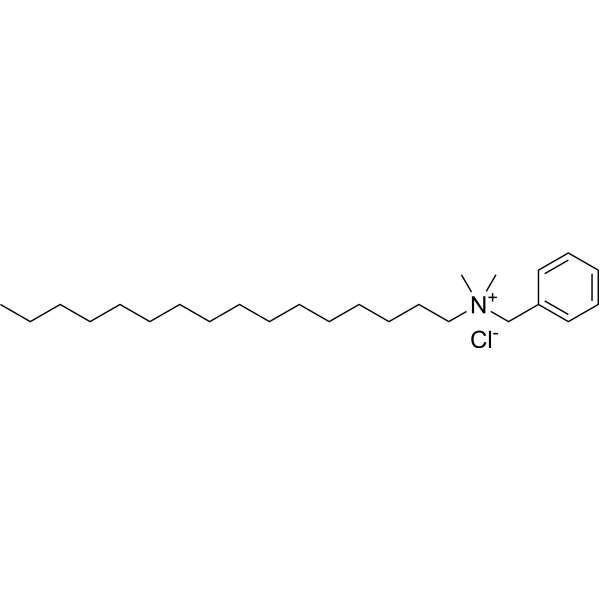
-
- HY-W089835
-
-
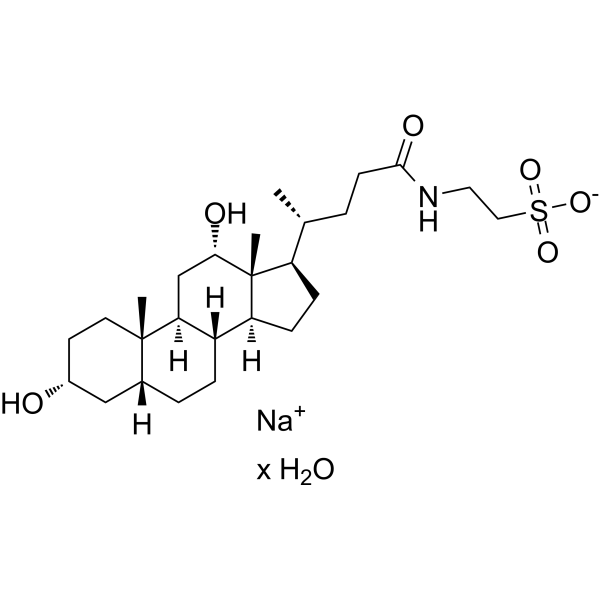
-
- HY-B1899A
-
|
Sodium taurodeoxycholate monohydrate
|
G protein-coupled Bile Acid Receptor 1
Endogenous Metabolite
|
Metabolic Disease
|
|
Taurodeoxycholic acid sodium hydrate (Sodium taurodeoxycholate monohydrate), a bile acid, is an amphiphilic surfactant molecule synthesized from cholesterol in the liver. Taurodeoxycholic acid sodium hydrate activates the S1PR2 pathway in addition to the TGR5 pathway .
|
-
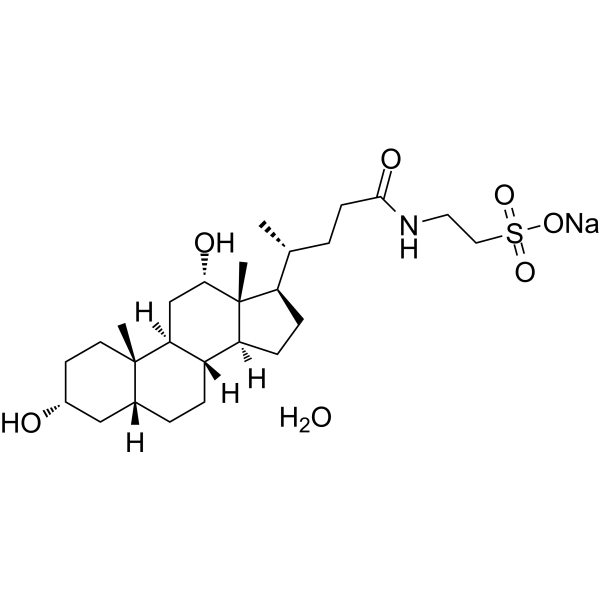
-
- HY-103406A
-
|
|
Dopamine Receptor
|
Neurological Disease
|
|
PNU-177864 hydrochloride is a potent, selective and orally active dopamine D3 receptor antagonist. PNU-177864 hydrochloride is structurally consistent with a cationic amphiphilic agent (CAD) and induces phospholipidosis in vivo. PNU-177864 hydrochloride antischizophrenic activity .
|
-
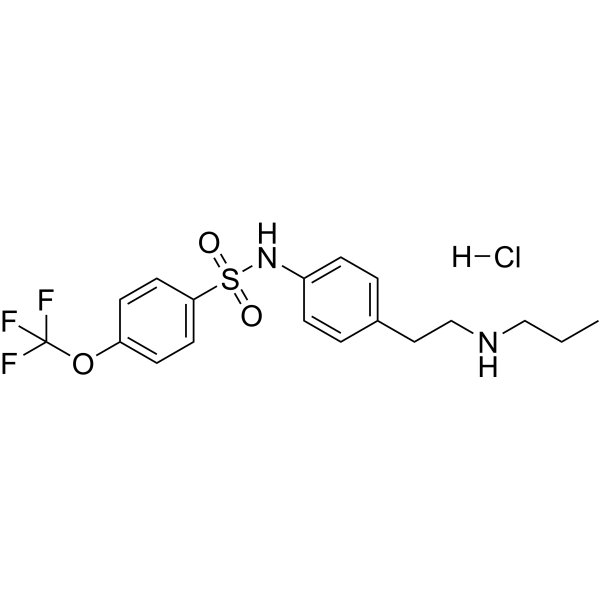
-
- HY-103406
-
|
|
Dopamine Receptor
|
Neurological Disease
|
|
PNU-177864 is a potent, selective and orally active dopamine D3 receptor antagonist. PNU-177864 is structurally consistent with a cationic amphiphilic agent (CAD) and induces phospholipidosis in vivo. PNU-177864 antischizophrenic activity .
|
-

-
- HY-W077279
-
|
N4-Acetyl-2'-deoxy-5'-O-DMT-cytidine
|
DNA/RNA Synthesis
|
Others
|
|
5'-O-DMT-N4-Ac-dC (N4-Acetyl-2'-deoxy-5'-O-DMT-cytidine, compound 7), a deoxynucleoside, can be used to synthesize of dodecyl phosphoramidite which is the raw material for dod‐DNA (amphiphilic DNA containing an internal hydrophobic region consisting of dodecyl phosphotriester linkages) synthesis .
|
-

-
- HY-163203
-
|
|
Bacterial
|
Infection
|
|
DDC18-8A is an amphiphilic dendrimer that exhibits high antibacterial and antibiofilm efficacy .
|
-
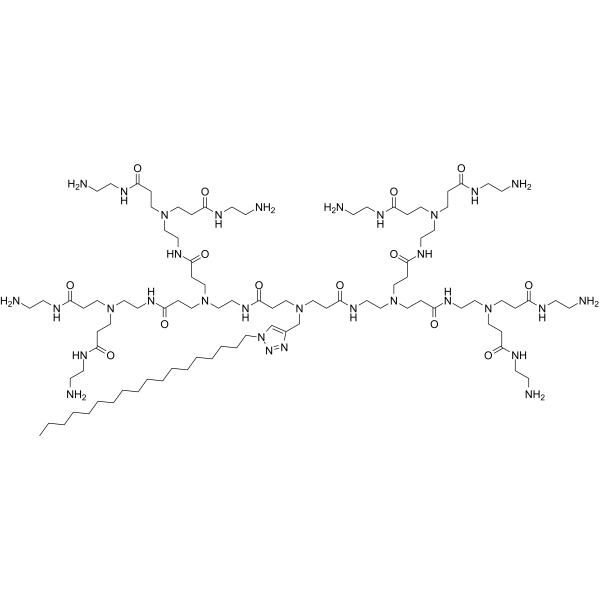
-
- HY-155902B
-
|
Maleimide-PEG-Hydroxy (MW 1000)
|
Liposome
|
Others
|
|
Mal-PEG-OH (MW 1000) was used as a macroinitiator to obtain amphiphilic diblock copolymers by ring-opening polymerization of LA. Nanoparticles prepared using amphiphilic block copolymers can form active drug delivery systems. Nanoparticles encapsulate Triptolide (HY-32735), which can avoid the disadvantage of Triptolide’s poor water solubility and reduce its toxicity.
|
-
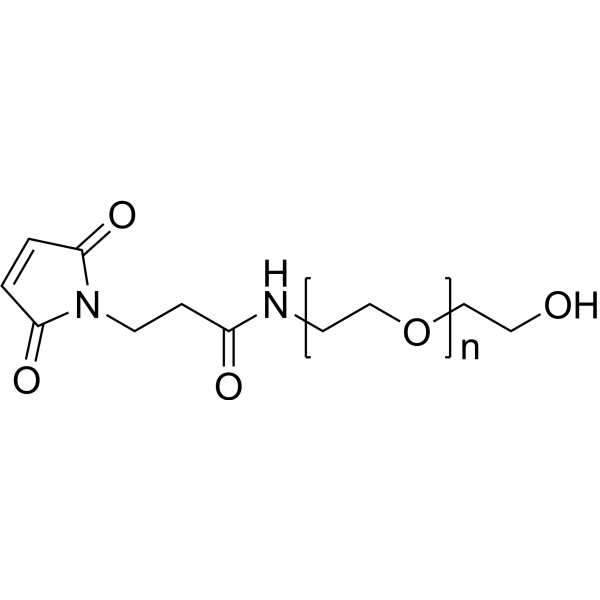
-
- HY-155902
-
|
Maleimide-PEG-Hydroxy (MW 5000)
|
Liposome
|
Others
|
|
Mal-PEG-OH (MW 5000) can be used as a macroinitiator to obtain amphiphilic diblock copolymers by ring-opening polymerization of LA. Nanoparticles prepared using amphiphilic block copolymers can form active drug delivery systems. Nanoparticles encapsulate Triptolide (HY-32735), which can avoid the disadvantage of Triptolide’s poor water solubility and reduce its toxicity.
|
-
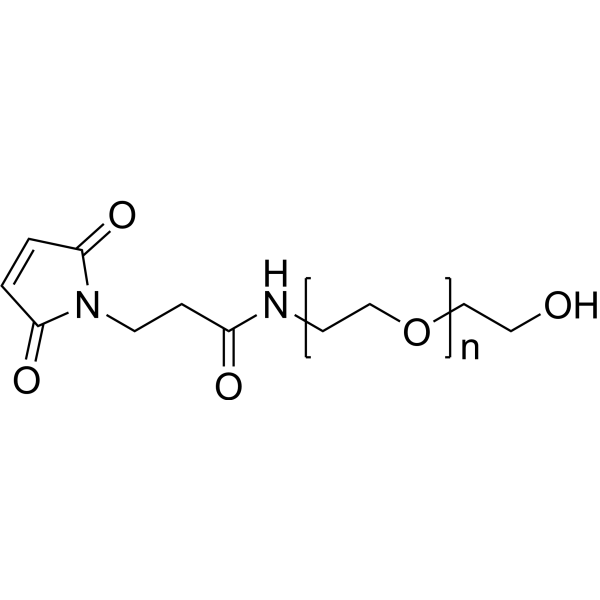
-
- HY-155902A
-
|
Maleimide-PEG-Hydroxy (MW 2000)
|
Liposome
|
Others
|
|
Mal-PEG-OH (MW 2000) can be used as a macroinitiator to obtain amphiphilic diblock copolymers by ring-opening polymerization of LA. Nanoparticles prepared using amphiphilic block copolymers can form active drug delivery systems. Nanoparticles encapsulate Triptolide (HY-32735), which can avoid the disadvantage of Triptolide’s poor water solubility and reduce its toxicity.
|
-
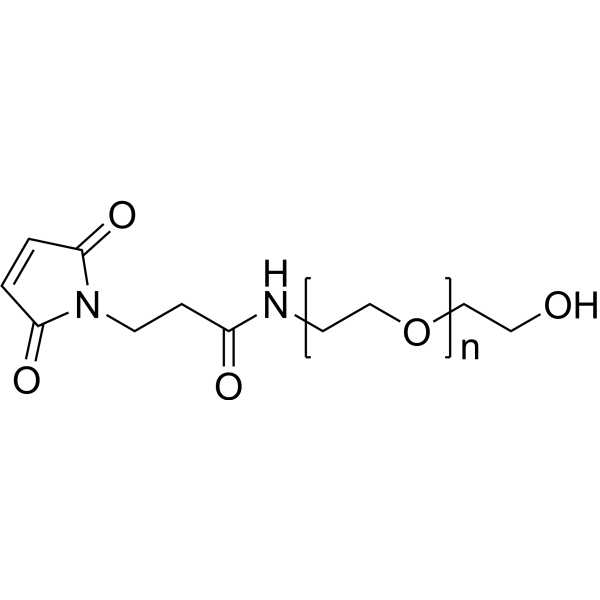
-
- HY-W440886
-
|
|
Liposome
|
|
|
DSPE-PEG-Biotin, MW 3400 is a phospholipid PEG for biotinylation. The amphiphilic property of the DSPE-PEG is useful for precision drug delivery and cancer therapy.
|
-

-
- HY-140696C
-
|
mPEG-Hydroxy (MW 20000); Polyethylene glycol monomethyl ether (MW 20000)
|
PROTAC Linkers
Liposome
|
Cancer
|
|
m-PEG-OH (MW 20000) can be used as a macroinitiator to participate in the synthesis of amphiphilic block copolymers. Nanoscale micelles can be prepared by using amphiphilic block copolymers to deliver active drugs. Paclitaxel (HY-B0015), a hydrophobic anticancer agent encapsulated in micelles, has stronger activity in killing cancer cells than free Paclitaxel. And it preferentially accumulates in tumor tissue with only limited distribution in healthy organs.
|
-
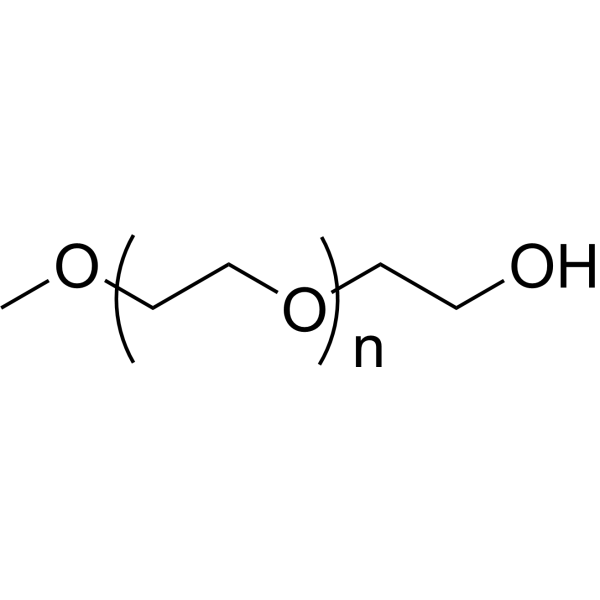
-
- HY-140696D
-
|
mPEG-Hydroxy (MW 10000); Polyethylene glycol monomethyl ether (MW 10000)
|
Liposome
|
Cancer
|
|
m-PEG-OH (MW 10000) can be used as a macroinitiator to participate in the synthesis of amphiphilic block copolymers. Amphiphilic block copolymers can be used to prepare nanoscale micelles to deliver active drugs. Paclitaxel (HY-B0015), a hydrophobic anticancer agent encapsulated in micelles, has stronger activity in killing cancer cells than free Paclitaxel. And it preferentially accumulates in tumor tissue with only limited distribution in healthy organs.
|
-
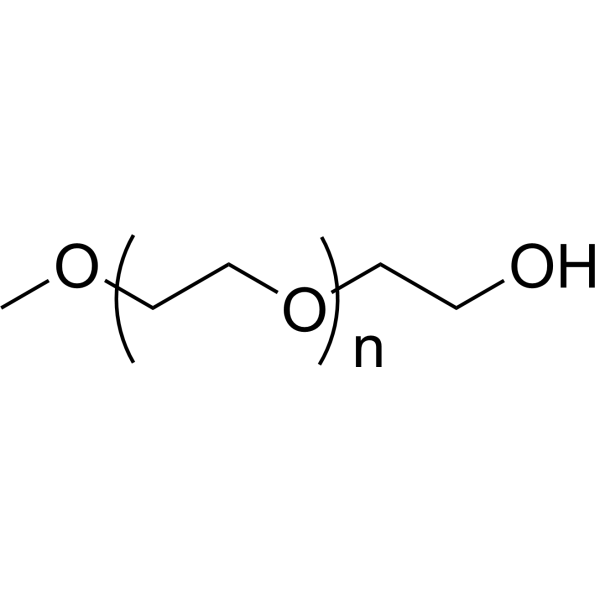
-
- HY-140696E
-
|
mPEG-Hydroxy (MW 1000); Polyethylene glycol monomethyl ether (MW 1000)
|
Liposome
|
Cancer
|
|
m-PEG-OH (MW 1000) can be used as a macroinitiator to participate in the synthesis of amphiphilic block copolymers. Amphiphilic block copolymers can be used to prepare nanoscale micelles to deliver active drugs. Paclitaxel (HY-B0015), a hydrophobic anticancer agent encapsulated in micelles, has stronger cancer-killing activity than free Paclitaxel. And it accumulates preferentially in tumor tissues and has only limited distribution in healthy organs.
|
-
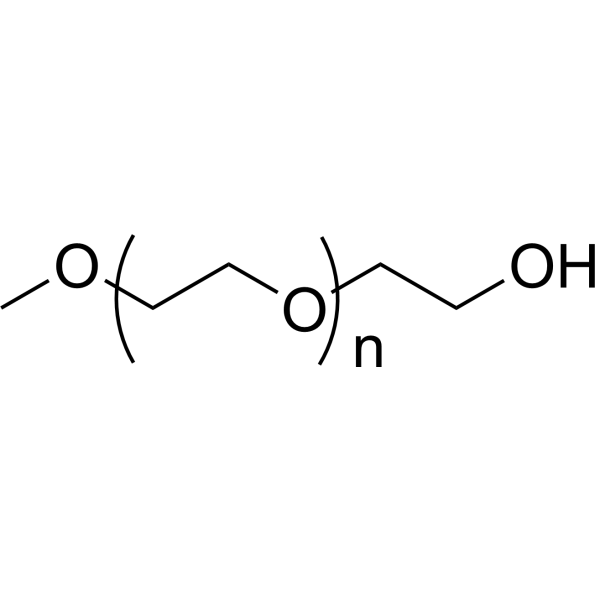
-
- HY-W441013
-
|
|
Liposome
|
Others
|
|
DSPE-PEG-NHS, MW 1000 is an amine reactive phospholipid. The reaction between NHS esters and amines forms a stable amide bond. The polymer is amphiphilic and capable of forming micelles or lipid bilayer in aqueous solution.
|
-
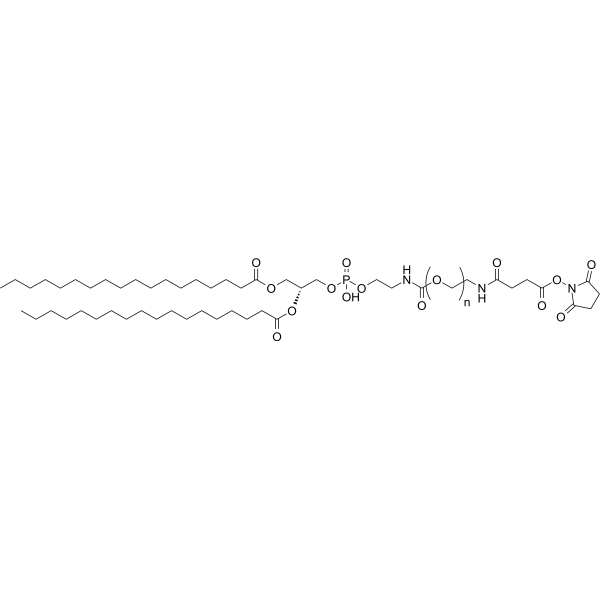
-
- HY-P1631
-
|
|
Bacterial
|
Infection
|
|
Polyphemusin I is a natural antimicrobial peptide with excellent antimicrobial activity against Gram-negative and Gram-positive bacteria. Polyphemusin I contains 18 amino acids and is stabilized into an amphiphilic, antiparallel β-hairpin by two disulfide bridges .
|
-
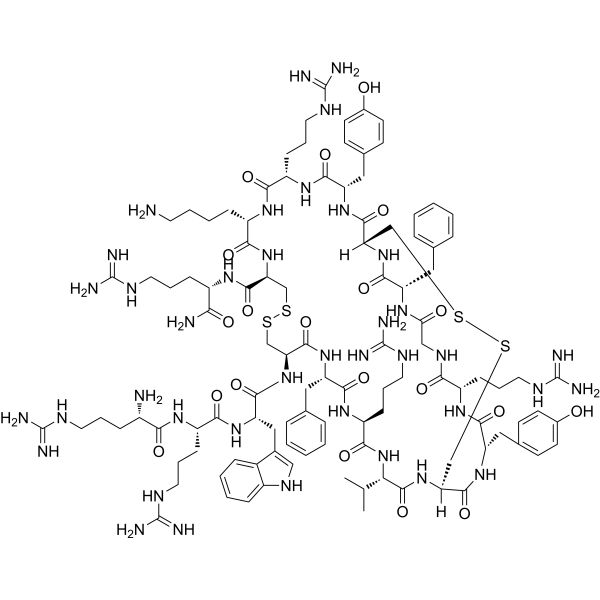
-
- HY-W440934
-
|
|
Liposome
|
|
|
Stearic acid-PEG-Rhodamine, MW 2000 is an amphiphilic PEG polymer which can form micelles in water. The rhodamine can be used for staining sample and easily traced by fluorescence microscopy. Rhodamine has maximum absorption at 570 nm and emission around 595 nm.
|
-

-
- HY-W048825
-
|
|
Amino Acid Derivatives
|
Others
|
|
Fmoc-Ala-Ala-OH (3) is a self-assemble fluorenylmethoxycarbonyl-dipeptide, which is a smaller amphiphilic building blocks consists dipeptides linked to fluore nylmethoxycarbonyl (Fmoc). Fmoc-Ala-Ala-OH can be used as scaffold materials in 3D cell culture .
|
-
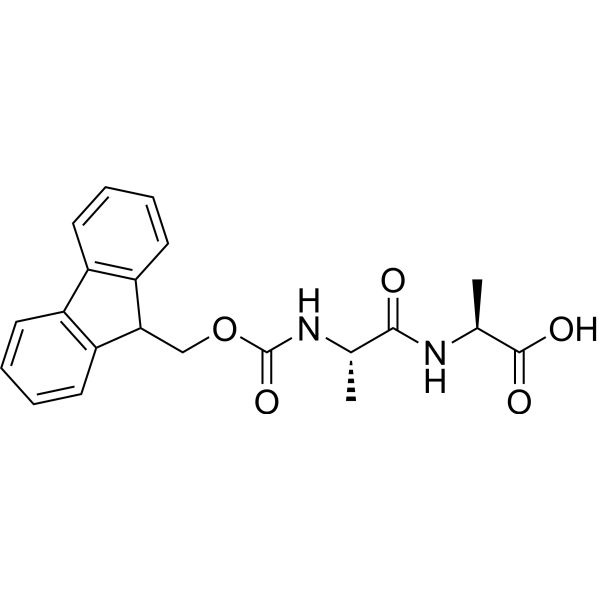
-
- HY-W588250
-
|
|
Integrin
|
Inflammation/Immunology
|
|
Surfactin C1 is an amphiphilic biosurfactants. Surfactin C1 inhibits leukemic cell (HL-60) adhesion to human umbilical vein endothelial cells (HUVEC). Surfactin C1 inhibits adhesion melecules expression, such as ICAM-1 and VCAM-1 .
|
-
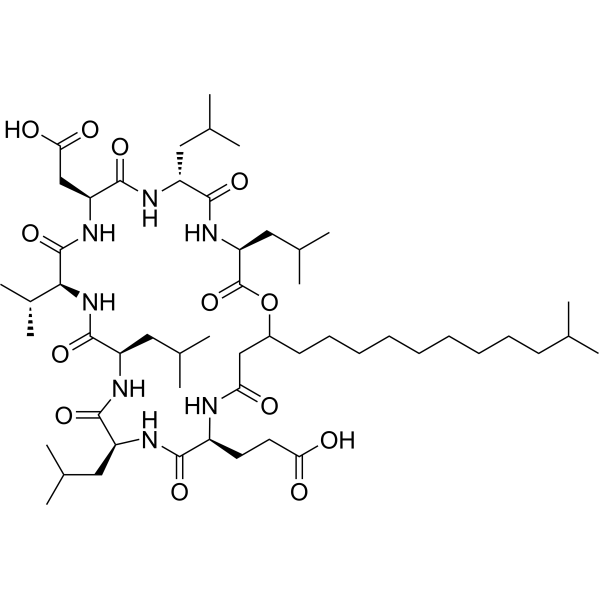
-
- HY-145942
-
|
|
Biochemical Assay Reagents
|
Inflammation/Immunology
|
|
Octenyl succinic anhydride can be used to esterify Starch to yield a hydrocolloid with amphiphilic properties, octenyl succinylated starch (OS-starch). Octenyl succinic anhydride (OSA) modification affects interaction between molecules on the outer surfaces of two starch granules by altering molecular structures on the outer surfaces .
|
-
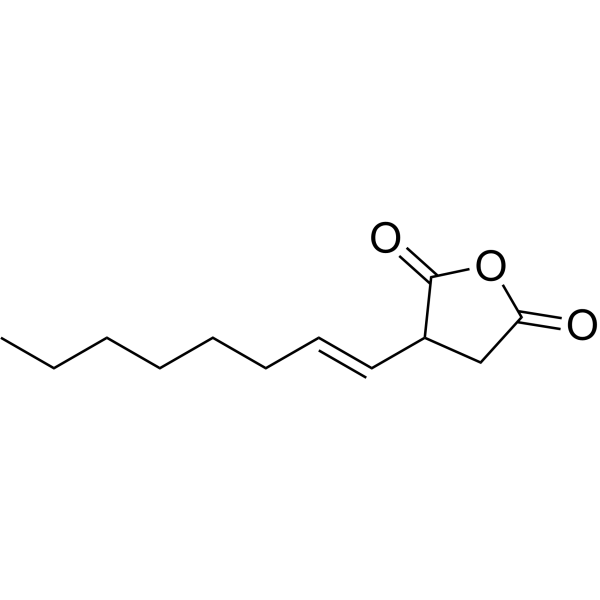
-
- HY-W440919
-
|
|
Liposome
|
|
|
DSPE-PEG-Rhodamine, MW 2000 is a dye functionalized phospholipid. The amphiphilic polymer can form lipid bilayer in water and be used to encapsulate therapeutic agents, such as liposomal anticancer drug or mRNA vaccine. Rhodamine has maximum absorption at 570 nm and emission around 595 nm and can be easily traced using an imaging technique.
|
-
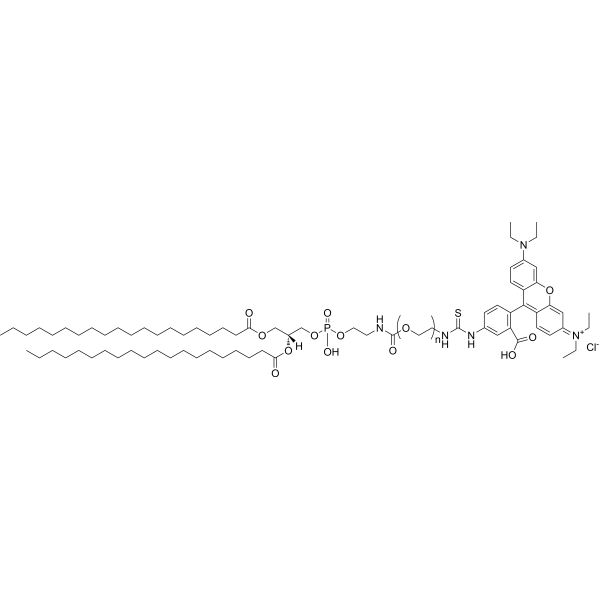
-
- HY-W099642
-
|
Trimethyl-n-octylammonium bromide
|
Biochemical Assay Reagents
|
Others
|
|
Trimethyloctylammonium bromide (TOAB) is used as a surfactant and phase transfer catalyst in various chemical reactions. TOAB can be used in the synthesis of nanomaterials due to its ability to selectively transfer ions across interfaces and as a surfactant in the production of emulsions and foams. It is valued for its amphiphilic properties, which allow it to interact with water and oils, stabilizing and dispersing mixtures.
|
-
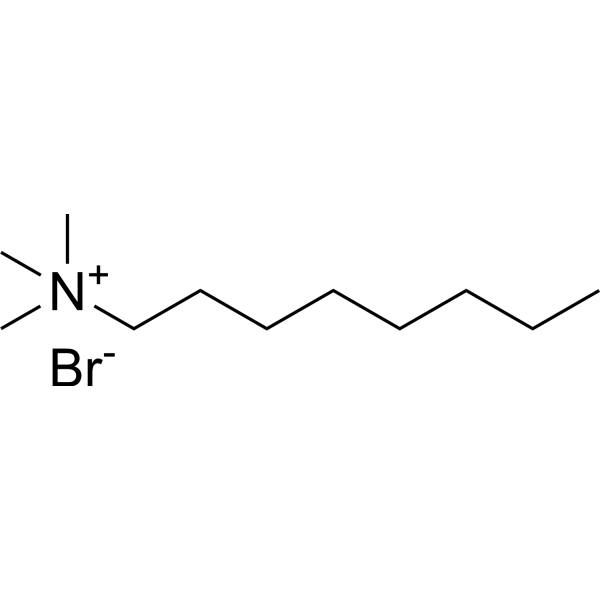
-
- HY-156004
-
|
|
Others
|
Others
|
|
Ziapin 2 is a molecular optomechanical light transducer. Ziapin 2 is an amphiphilic azobenzene with a strong non-covalent affinity to the plasma membrane. Ziapin 2 can be used to photo-modulate the membrane potential in cells of the Gram-positive bacterium Bacillus subtilis. Ziapin 2 enters the lipid membrane very rapidly (≈ 40 ns) .
|
-
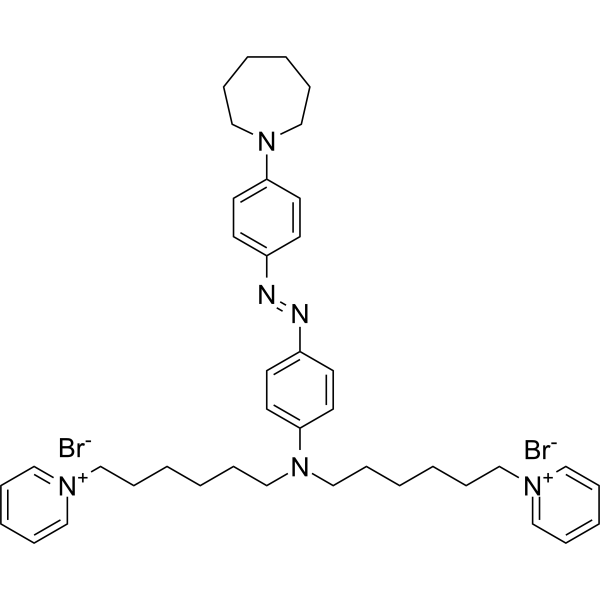
-
- HY-100557
-
|
|
|
|
|
Hydroxypropyl Cellulose is somewhat amphiphilic in character and is a surfactant. Hydroxypropyl Cellulose can be used as a pharmaceutical excipient, such as coating agent, emulsifier, suspension, tablet, thickener, viscosifier. Pharmaceutical excipients, or pharmaceutical auxiliaries, refer to other chemical substances used in the pharmaceutical process other than pharmaceutical ingredients. Pharmaceutical excipients generally refer to inactive ingredients in pharmaceutical preparations, which can improve the stability, solubility and processability of pharmaceutical preparations. Pharmaceutical excipients also affect the absorption, distribution, metabolism, and elimination (ADME) processes of co-administered drugs .
|
-

| Cat. No. |
Product Name |
Type |
-
- HY-W077279
-
|
N4-Acetyl-2'-deoxy-5'-O-DMT-cytidine
|
Gene Sequencing and Synthesis
|
|
5'-O-DMT-N4-Ac-dC (N4-Acetyl-2'-deoxy-5'-O-DMT-cytidine, compound 7), a deoxynucleoside, can be used to synthesize of dodecyl phosphoramidite which is the raw material for dod‐DNA (amphiphilic DNA containing an internal hydrophobic region consisting of dodecyl phosphotriester linkages) synthesis .
|
-
- HY-157922
-
|
α-D-Glucopyranosyl-α-D-glucopyranoside monododecanoate
|
Surfactants
|
|
Trehalose C12 (α-D-Glucopyranosyl-α-D-glucopyranoside monododecanoate) is a nonreducing disaccharide with amphiphilic property, which is used as emulsifier, surfactant, encapsulating materials, and in the biochemical researches of cellular processes and membrane interactions .
|
-
- HY-155902B
-
|
Maleimide-PEG-Hydroxy (MW 1000)
|
Drug Delivery
|
|
Mal-PEG-OH (MW 1000) was used as a macroinitiator to obtain amphiphilic diblock copolymers by ring-opening polymerization of LA. Nanoparticles prepared using amphiphilic block copolymers can form active drug delivery systems. Nanoparticles encapsulate Triptolide (HY-32735), which can avoid the disadvantage of Triptolide’s poor water solubility and reduce its toxicity.
|
-
- HY-155902
-
|
Maleimide-PEG-Hydroxy (MW 5000)
|
Drug Delivery
|
|
Mal-PEG-OH (MW 5000) can be used as a macroinitiator to obtain amphiphilic diblock copolymers by ring-opening polymerization of LA. Nanoparticles prepared using amphiphilic block copolymers can form active drug delivery systems. Nanoparticles encapsulate Triptolide (HY-32735), which can avoid the disadvantage of Triptolide’s poor water solubility and reduce its toxicity.
|
-
- HY-155902A
-
|
Maleimide-PEG-Hydroxy (MW 2000)
|
Drug Delivery
|
|
Mal-PEG-OH (MW 2000) can be used as a macroinitiator to obtain amphiphilic diblock copolymers by ring-opening polymerization of LA. Nanoparticles prepared using amphiphilic block copolymers can form active drug delivery systems. Nanoparticles encapsulate Triptolide (HY-32735), which can avoid the disadvantage of Triptolide’s poor water solubility and reduce its toxicity.
|
-
- HY-W440886
-
|
|
Drug Delivery
|
|
DSPE-PEG-Biotin, MW 3400 is a phospholipid PEG for biotinylation. The amphiphilic property of the DSPE-PEG is useful for precision drug delivery and cancer therapy.
|
-
- HY-140696C
-
|
mPEG-Hydroxy (MW 20000); Polyethylene glycol monomethyl ether (MW 20000)
|
Drug Delivery
|
|
m-PEG-OH (MW 20000) can be used as a macroinitiator to participate in the synthesis of amphiphilic block copolymers. Nanoscale micelles can be prepared by using amphiphilic block copolymers to deliver active drugs. Paclitaxel (HY-B0015), a hydrophobic anticancer agent encapsulated in micelles, has stronger activity in killing cancer cells than free Paclitaxel. And it preferentially accumulates in tumor tissue with only limited distribution in healthy organs.
|
-
- HY-140696D
-
|
mPEG-Hydroxy (MW 10000); Polyethylene glycol monomethyl ether (MW 10000)
|
Drug Delivery
|
|
m-PEG-OH (MW 10000) can be used as a macroinitiator to participate in the synthesis of amphiphilic block copolymers. Amphiphilic block copolymers can be used to prepare nanoscale micelles to deliver active drugs. Paclitaxel (HY-B0015), a hydrophobic anticancer agent encapsulated in micelles, has stronger activity in killing cancer cells than free Paclitaxel. And it preferentially accumulates in tumor tissue with only limited distribution in healthy organs.
|
-
- HY-140696E
-
|
mPEG-Hydroxy (MW 1000); Polyethylene glycol monomethyl ether (MW 1000)
|
Drug Delivery
|
|
m-PEG-OH (MW 1000) can be used as a macroinitiator to participate in the synthesis of amphiphilic block copolymers. Amphiphilic block copolymers can be used to prepare nanoscale micelles to deliver active drugs. Paclitaxel (HY-B0015), a hydrophobic anticancer agent encapsulated in micelles, has stronger cancer-killing activity than free Paclitaxel. And it accumulates preferentially in tumor tissues and has only limited distribution in healthy organs.
|
-
- HY-W441013
-
|
|
Drug Delivery
|
|
DSPE-PEG-NHS, MW 1000 is an amine reactive phospholipid. The reaction between NHS esters and amines forms a stable amide bond. The polymer is amphiphilic and capable of forming micelles or lipid bilayer in aqueous solution.
|
-
- HY-W440934
-
|
|
Drug Delivery
|
|
Stearic acid-PEG-Rhodamine, MW 2000 is an amphiphilic PEG polymer which can form micelles in water. The rhodamine can be used for staining sample and easily traced by fluorescence microscopy. Rhodamine has maximum absorption at 570 nm and emission around 595 nm.
|
-
- HY-145942
-
|
|
Biochemical Assay Reagents
|
|
Octenyl succinic anhydride can be used to esterify Starch to yield a hydrocolloid with amphiphilic properties, octenyl succinylated starch (OS-starch). Octenyl succinic anhydride (OSA) modification affects interaction between molecules on the outer surfaces of two starch granules by altering molecular structures on the outer surfaces .
|
-
- HY-W440919
-
|
|
Drug Delivery
|
|
DSPE-PEG-Rhodamine, MW 2000 is a dye functionalized phospholipid. The amphiphilic polymer can form lipid bilayer in water and be used to encapsulate therapeutic agents, such as liposomal anticancer drug or mRNA vaccine. Rhodamine has maximum absorption at 570 nm and emission around 595 nm and can be easily traced using an imaging technique.
|
-
- HY-W099642
-
|
Trimethyl-n-octylammonium bromide
|
Biochemical Assay Reagents
|
|
Trimethyloctylammonium bromide (TOAB) is used as a surfactant and phase transfer catalyst in various chemical reactions. TOAB can be used in the synthesis of nanomaterials due to its ability to selectively transfer ions across interfaces and as a surfactant in the production of emulsions and foams. It is valued for its amphiphilic properties, which allow it to interact with water and oils, stabilizing and dispersing mixtures.
|
| Cat. No. |
Product Name |
Target |
Research Area |
-
- HY-P2529
-
|
|
Peptides
|
Others
|
|
Penetratin is a peptide derived from the amphiphilic Drosophila Antennapedia homeodomain .
|
-
- HY-P4076
-
|
|
Peptides
|
Cancer
|
|
MPG peptides, Pβ is a primary amphiphilic peptide consisting of three domains .
|
-
- HY-P2530
-
|
|
Peptides
|
Others
|
|
KALA is an amphiphilic peptide that forms an α-helical structure at physiological pH. KALA modifies a plasmid DNA-encapsulating liposomal membrane and is used as a fusogenic peptide in order to achieve effective liver targeting and transfection of DNA via galactose receptors .
|
-
- HY-P5067
-
|
|
Peptides
|
Others
|
|
EAK16-II is an amphipathic peptide that inhibits the self-sorting of EAKIIH6 in a concentration-dependent manner .
|
-
- HY-P1631
-
|
|
Bacterial
|
Infection
|
|
Polyphemusin I is a natural antimicrobial peptide with excellent antimicrobial activity against Gram-negative and Gram-positive bacteria. Polyphemusin I contains 18 amino acids and is stabilized into an amphiphilic, antiparallel β-hairpin by two disulfide bridges .
|
-
- HY-W048825
-
|
|
Amino Acid Derivatives
|
Others
|
|
Fmoc-Ala-Ala-OH (3) is a self-assemble fluorenylmethoxycarbonyl-dipeptide, which is a smaller amphiphilic building blocks consists dipeptides linked to fluore nylmethoxycarbonyl (Fmoc). Fmoc-Ala-Ala-OH can be used as scaffold materials in 3D cell culture .
|
-
- HY-W588250
-
|
|
Integrin
|
Inflammation/Immunology
|
|
Surfactin C1 is an amphiphilic biosurfactants. Surfactin C1 inhibits leukemic cell (HL-60) adhesion to human umbilical vein endothelial cells (HUVEC). Surfactin C1 inhibits adhesion melecules expression, such as ICAM-1 and VCAM-1 .
|
-
- HY-P5727
-
|
|
Peptides
|
Infection
|
|
HR1 is a mastoid protease. HR1 can increase the permeability of human erythrocyte membrane. HR1 can induce cytoplasmic membrane permeation in bacteria and mast cells .
|
-
- HY-W007599
-
|
|
Peptides
|
Cancer
|
|
(S)-2,6-Bis((tert-butoxycarbonyl)amino)hexanoic acid is a polypeptide derivative, can be used to synthesis multifunctional amphiphilic peptide dendrimer, as a nonviral gene vectors, realizes the method in cancer research. (S)-2,6-Bis((tert-butoxycarbonyl)amino)hexanoic acid also involves in the synthesis of an organic substance that increases the luminescence intensity of alkaline phosphatase substrates .
|
-
- HY-P4121
-
|
|
Peptides
|
Metabolic Disease
|
|
L17E, an endosomolytic peptide, is a cationic amphiphilic peptide with specific membrane lytic activity for late endosomes (LEs). L17E diminishes the TS5-p45 induced apoptosis in a dose-dependent manner. L17E is endocytosed into cells and trafficked to LEs. Within the acidic environment of LEs, L17E perturbs and lyses the LE membrane, leading to disruption of LE membrane and release of LE content to the cytosol. L17E is used to investigate the role of the endosomal protein trafficking pathway .
|
| Cat. No. |
Product Name |
Category |
Target |
Chemical Structure |
Your information is safe with us. * Required Fields.
Inquiry Information
- Product Name:
- Cat. No.:
- Quantity:
- MCE Japan Authorized Agent:

































